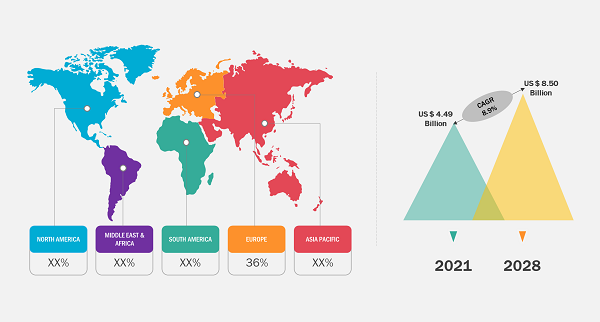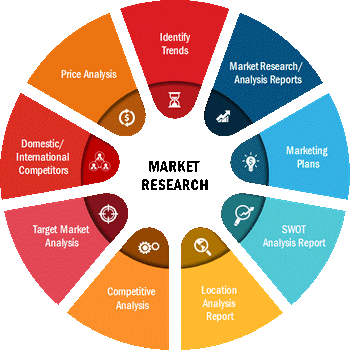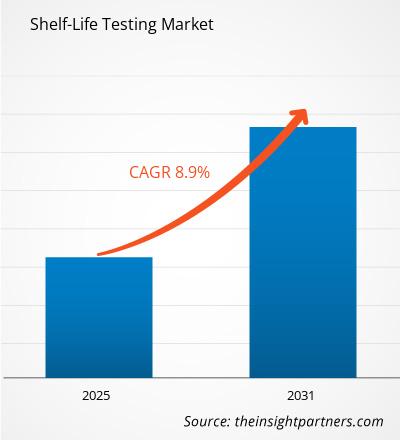Si prevede che il mercato dei test sulla durata di conservazione crescerà da 4,49 miliardi di dollari nel 2021 agli Stati Uniti 8,50 miliardi di dollari entro il 2031; si stima che crescerà a un CAGR dell'8,9% tra il 2022 e il 2031.
L'industria della trasformazione alimentare è fiorita rapidamente nel corso degli anni. Inoltre, la domanda di prodotti alimentari confezionati e pronti al consumo sta crescendo notevolmente. I consumatori preferiscono prodotti alimentari confezionati facili da cucinare a causa del loro stile di vita frenetico. Inoltre, la crescente incidenza di malattie di origine alimentare e di intossicazioni alimentari esercita pressioni sui produttori alimentari affinché applichino test sulla durata di conservazione. Tutti questi fattori stanno spingendo la crescita del mercato della durata di conservazione.
DINAMICHE DEL MERCATO
I test sulla durata di conservazione vengono eseguiti in laboratorio per determinare la durata di conservazione prevista di un prodotto alimentare e quando dovrebbe essere consumato. Il test garantisce che il prodotto sia sicuro per il consumo. Riduce inoltre la probabilità di richiami di prodotti; identifica le cause della ridotta conservabilità; aiuta a migliorare prodotti, processi e redditività. L'introduzione di rigorose norme di sicurezza per i prodotti alimentari e la crescente epidemia di malattie di origine alimentare stimolano il mercato dei test sulla durata di conservazione in crescita. Inoltre, la crescente domanda di prodotti alimentari confezionati e pronti contribuisce alla crescita del mercato.
AMBITO DI MERCATO
La "durata di conservazione globale" Il rapporto Testing Market Forecast to 2031" mira a fornire una panoramica del mercato dei test sulla durata di conservazione con una segmentazione dettagliata del mercato basata su parametri, alimenti testati, metodo e tecnologia. Il rapporto fornisce statistiche chiave basate sulla performance finanziaria del principale attore del mercato. Offre inoltre tendenze e opportunità chiave nel mercato dei test sulla durata di conservazione.
Approfondimenti strategici
MERCATO SEGMENTAZIONE
Il mercato globale dei test sulla durata di conservazione è segmentato sulla base di: parametro, cibo testato, metodo e tecnologia. In base ai parametri, il mercato è segmentato in contaminazione microbica, irrancidimento, stabilità dei nutrienti, proprietà organolettiche e altri. In termini di alimenti testati, il mercato è segmentato in alimenti confezionati, bevande, prodotti da forno e dolciari, carne e prodotti a base di carne, latticini e prodotti lattiero-caseari, dessert, frutta e verdura trasformata e altri. In base al metodo, il mercato globale dei test sulla durata di conservazione è diviso in test sulla durata di conservazione in tempo reale e test sulla durata di conservazione accelerati. In base alla tecnologia, il mercato è segmentato in apparecchiature e test manuali e basati su kit.
I test globali sulla durata di conservazione è segmentato in cinque regioni principali: Nord America, Europa, Asia-Pacifico (APAC), Medio Oriente e Asia. Africa (MEA) e Sud America. Il rapporto copre l'analisi e le previsioni di 18 paesi a livello globale insieme alle tendenze attuali e alle opportunità prevalenti nella regione.
Dal punto di vista regionale, l'Europa domina il mercato dei test sulla durata di conservazione. La crescita del mercato in Europa è guidata dal maggior numero di laboratori di analisi con un elevato numero di campioni testati nel mondo. Inoltre, nella regione esistono numerose normative rigorose in materia di sicurezza alimentare che sono soggette a frequenti aggiornamenti. Come risultato di una rigorosa applicazione normativa in tutte le fasi della catena di approvvigionamento alimentare, in Europa viene condotto il maggior numero di test a campione per scopi di sicurezza e qualità. La figura seguente mostra il trend di crescita dei ricavi nel mercato dei test sulla durata di conservazione in Europa:
 Fonte: The Insight Partners Analysis
Fonte: The Insight Partners Analysis
Il rapporto analizza fattori quali fattori trainanti, restrizioni, opportunità e tendenze future, che incidono sulla crescita del mercato dei test di durata di conservazione. Il rapporto fornisce anche un'analisi esaustiva delle cinque forze di Porter evidenziando i fattori che influenzano il mercato in queste regioni.
IMPATTO DELLA PANDEMIA DA COVID-19
Durante la pandemia di COVID-19, l'industria alimentare e delle bevande ha dovuto affrontare sfide senza precedenti dovute alla carenza di materie prime, alla chiusura delle fabbriche, alla carenza di manodopera e ad altre difficoltà operative previste dai protocolli di sicurezza contro la pandemia. La chiusura delle unità produttive, le difficoltà nell’approvvigionamento delle materie prime e le restrizioni sulla logistica hanno avuto un impatto negativo sul mercato dei test sulla durata di conservazione. L’epidemia aveva distorto l’efficienza operativa e interrotto le catene del valore a causa dell’improvvisa chiusura dei confini nazionali e internazionali, creando perdite di entrate e danni. Il blocco iniziale in vari paesi ha sicuramente influito sulla produzione di prodotti alimentari, influenzando negativamente il mercato dei test di conservabilità. Seguendo le linee guida statali e regionali, i produttori hanno implementato ampie misure per proteggere la salute e la sicurezza dei propri dipendenti. Molti produttori globali hanno temporaneamente chiuso le loro attività o limitato la capacità produttiva. Inoltre, nel primo periodo della crisi, i produttori dipendevano in larga misura dalle scorte. Oltre a ciò, a causa del blocco durante la pandemia, sono state chiuse le strutture alimentari e di ospitalità come ristoranti e hotel, con un impatto negativo sul mercato dei test sulla durata di conservazione. La chiusura delle strutture di distribuzione come supermercati & anche gli ipermercati e i negozi specializzati hanno avuto un impatto negativo sul mercato dei test sulla durata di conservazione.
ATTORI DEL MERCATO
I rapporti coprono gli sviluppi chiave nel mercato dei test sulla durata di conservazione. Diverse aziende si stanno concentrando su strategie di crescita organica, come lanci di prodotti, approvazioni di prodotti, brevetti ed eventi. Inoltre, acquisizioni e partnership & le collaborazioni sono tra le strategie di crescita inorganica testimoniate nel mercato. Queste attività hanno aperto la strada all'espansione del business e della base clienti degli operatori del mercato. Si prevede che gli attori che operano nel mercato dei test sulla durata di conservazione sperimenteranno opportunità di crescita redditizie in futuro grazie alla crescente domanda di test sulla durata di conservazione.
Il rapporto include i profili delle principali società di mercato dei test di durata di conservazione insieme alle loro analisi SWOT e strategie di mercato. Inoltre, il rapporto si concentra sui principali attori del settore con informazioni quali profili aziendali, componenti e servizi offerti, informazioni finanziarie degli ultimi tre anni e sviluppi chiave negli ultimi cinque anni.
Di seguito è riportato l'elenco di alcune aziende impegnate nel mercato dei test sulla durata di conservazione.
- •TÜV SÜD•Mérieux•AsureQuality •RJ Hill Laboratories•Intertek Group plc•SCS Global•Tecnologia agroalimentare•Laboratori Symbio•Microchem Lab Services•Premier Analytical Services
Il team di ricerca e analisi del partner Insight è composto da professionisti esperti con competenze statistiche avanzate e offre varie opzioni di personalizzazione nello studio esistente.

- Analisi storica (2 anni), anno base, previsione (7 anni) con CAGR
- Analisi PEST e SWOT
- Valore/volume delle dimensioni del mercato - Globale, regionale, nazionale
- Industria e panorama competitivo
- Set di dati Excel



Report Coverage
Revenue forecast, Company Analysis, Industry landscape, Growth factors, and Trends

Segment Covered
This text is related
to segments covered.

Regional Scope
North America, Europe, Asia Pacific, Middle East & Africa, South & Central America

Country Scope
This text is related
to country scope.
Trends and growth analysis reports related to Consumer Goods : READ MORE..
The List of Companies
- TÜV SÜD
- Mérieux
- AsureQuality
- RJ Hill Laboratories
- Intertek Group plc
- SCS Global
- Agrifood Technology
- Symbio Laboratories
- Microchem Lab Services
- Premier Analytical Services
The Insight Partners performs research in 4 major stages: Data Collection & Secondary Research, Primary Research, Data Analysis and Data Triangulation & Final Review.
- Data Collection and Secondary Research:
As a market research and consulting firm operating from a decade, we have published and advised several client across the globe. First step for any study will start with an assessment of currently available data and insights from existing reports. Further, historical and current market information is collected from Investor Presentations, Annual Reports, SEC Filings, etc., and other information related to company’s performance and market positioning are gathered from Paid Databases (Factiva, Hoovers, and Reuters) and various other publications available in public domain.
Several associations trade associates, technical forums, institutes, societies and organization are accessed to gain technical as well as market related insights through their publications such as research papers, blogs and press releases related to the studies are referred to get cues about the market. Further, white papers, journals, magazines, and other news articles published in last 3 years are scrutinized and analyzed to understand the current market trends.
- Primary Research:
The primarily interview analysis comprise of data obtained from industry participants interview and answers to survey questions gathered by in-house primary team.
For primary research, interviews are conducted with industry experts/CEOs/Marketing Managers/VPs/Subject Matter Experts from both demand and supply side to get a 360-degree view of the market. The primary team conducts several interviews based on the complexity of the markets to understand the various market trends and dynamics which makes research more credible and precise.
A typical research interview fulfils the following functions:
- Provides first-hand information on the market size, market trends, growth trends, competitive landscape, and outlook
- Validates and strengthens in-house secondary research findings
- Develops the analysis team’s expertise and market understanding
Primary research involves email interactions and telephone interviews for each market, category, segment, and sub-segment across geographies. The participants who typically take part in such a process include, but are not limited to:
- Industry participants: VPs, business development managers, market intelligence managers and national sales managers
- Outside experts: Valuation experts, research analysts and key opinion leaders specializing in the electronics and semiconductor industry.
Below is the breakup of our primary respondents by company, designation, and region:

Once we receive the confirmation from primary research sources or primary respondents, we finalize the base year market estimation and forecast the data as per the macroeconomic and microeconomic factors assessed during data collection.
- Data Analysis:
Once data is validated through both secondary as well as primary respondents, we finalize the market estimations by hypothesis formulation and factor analysis at regional and country level.
- Macro-Economic Factor Analysis:
We analyse macroeconomic indicators such the gross domestic product (GDP), increase in the demand for goods and services across industries, technological advancement, regional economic growth, governmental policies, the influence of COVID-19, PEST analysis, and other aspects. This analysis aids in setting benchmarks for various nations/regions and approximating market splits. Additionally, the general trend of the aforementioned components aid in determining the market's development possibilities.
- Country Level Data:
Various factors that are especially aligned to the country are taken into account to determine the market size for a certain area and country, including the presence of vendors, such as headquarters and offices, the country's GDP, demand patterns, and industry growth. To comprehend the market dynamics for the nation, a number of growth variables, inhibitors, application areas, and current market trends are researched. The aforementioned elements aid in determining the country's overall market's growth potential.
- Company Profile:
The “Table of Contents” is formulated by listing and analyzing more than 25 - 30 companies operating in the market ecosystem across geographies. However, we profile only 10 companies as a standard practice in our syndicate reports. These 10 companies comprise leading, emerging, and regional players. Nonetheless, our analysis is not restricted to the 10 listed companies, we also analyze other companies present in the market to develop a holistic view and understand the prevailing trends. The “Company Profiles” section in the report covers key facts, business description, products & services, financial information, SWOT analysis, and key developments. The financial information presented is extracted from the annual reports and official documents of the publicly listed companies. Upon collecting the information for the sections of respective companies, we verify them via various primary sources and then compile the data in respective company profiles. The company level information helps us in deriving the base number as well as in forecasting the market size.
- Developing Base Number:
Aggregation of sales statistics (2020-2022) and macro-economic factor, and other secondary and primary research insights are utilized to arrive at base number and related market shares for 2022. The data gaps are identified in this step and relevant market data is analyzed, collected from paid primary interviews or databases. On finalizing the base year market size, forecasts are developed on the basis of macro-economic, industry and market growth factors and company level analysis.
- Data Triangulation and Final Review:
The market findings and base year market size calculations are validated from supply as well as demand side. Demand side validations are based on macro-economic factor analysis and benchmarks for respective regions and countries. In case of supply side validations, revenues of major companies are estimated (in case not available) based on industry benchmark, approximate number of employees, product portfolio, and primary interviews revenues are gathered. Further revenue from target product/service segment is assessed to avoid overshooting of market statistics. In case of heavy deviations between supply and demand side values, all thes steps are repeated to achieve synchronization.
We follow an iterative model, wherein we share our research findings with Subject Matter Experts (SME’s) and Key Opinion Leaders (KOLs) until consensus view of the market is not formulated – this model negates any drastic deviation in the opinions of experts. Only validated and universally acceptable research findings are quoted in our reports.
We have important check points that we use to validate our research findings – which we call – data triangulation, where we validate the information, we generate from secondary sources with primary interviews and then we re-validate with our internal data bases and Subject matter experts. This comprehensive model enables us to deliver high quality, reliable data in shortest possible time.

 Ottieni un campione gratuito per questo repot
Ottieni un campione gratuito per questo repot